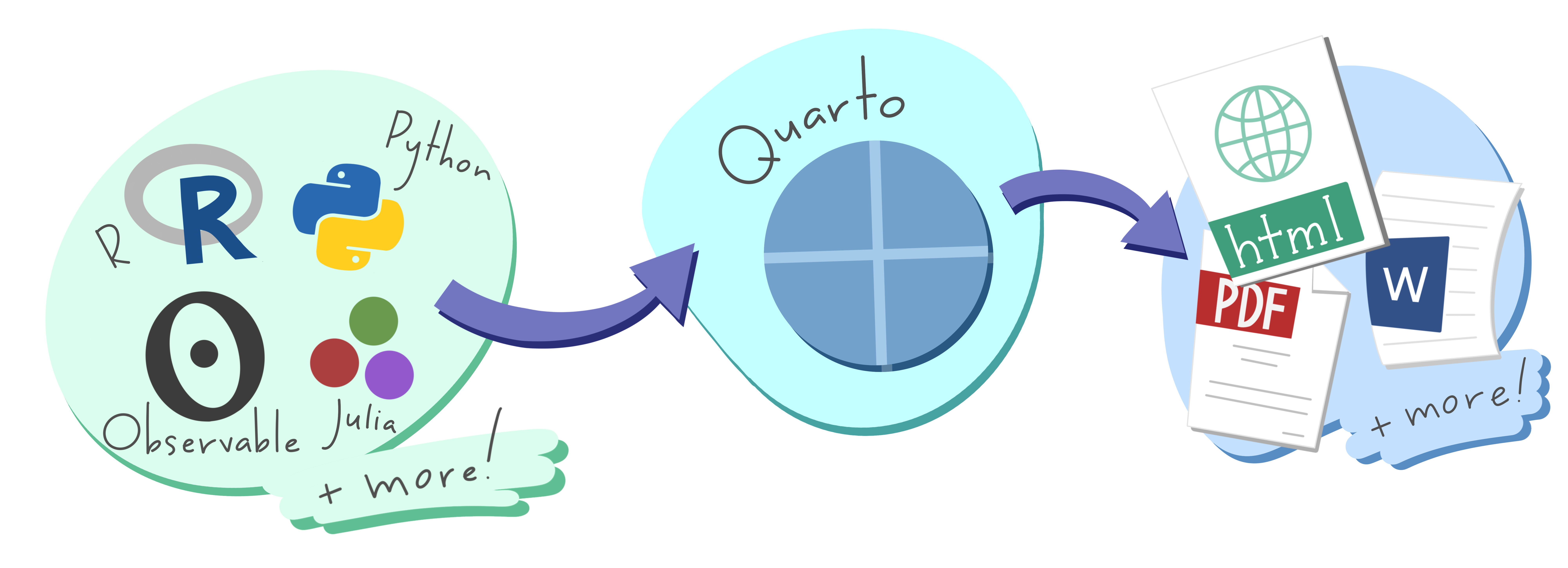Welcome to INFO 526
Data Visualization and Analysis
University of Arizona
INFO 526 - Summer 2024
Course Details
Teaching team
Timetable
- Lectures (weekly)
- Online (asynchronous)
- Course dates
- 05/13/2024 - 06/28/2024
Themes: what, why, and how
- What: the plot
- Specific types of visualizations for a particular purpose (e.g., maps for spatial data, Sankey diagrams for proportions, etc.)
- Tooling to produce them (e.g., specific R packages)
- How: the process
- Start with a design (sketch + pseudo code)
- Pre-process data (e.g., wrangle, reshape, join, etc.)
- Map data to aesthetics
- Make visual encoding decisions t(e.g., address accessibility concerns)
- Post-process for visual appeal and annotation
- Why: the theory
- Tie together “how” and “what” through the grammar of graphics
Course components
Course website
aka “the one link to rule them all”
Lectures
Asynchronous online (recorded)
Content:
Traditional lecture (mostly)
Live coding + demos
Announcements
Sent via Slack, be sure to check regularly
I’ll assume that you’ve read an announcement by the next “business” day
Diversity and inclusion
It is my intent that students from all diverse backgrounds and perspectives be well-served by this course, that students’ learning needs be addressed both in and out of class, and that the diversity that the students bring to this class be viewed as a resource, strength and benefit.
If you have a name that differs from those that appear in your official UArizona records, please let me know!
Please let me know your preferred pronouns.
If you feel like your performance in the class is being impacted by your experiences outside of class, please don’t hesitate to come and talk with me. I want to be a resource for you. If you prefer to speak with someone outside of the course, your advisers and deans are excellent resources.
I (like many people) am still in the process of learning about diverse perspectives and identities. If something was said in class (by anyone) that made you feel uncomfortable, please talk to me about it.
Accessibility
The Disability Resource Center is available to ensure that students are able to engage with their courses and related assignments.
I am committed to making all course materials accessible and I’m always learning how to do this better. If any course component is not accessible to you in any way, please don’t hesitate to let me know.
Assessments
Attendance + participation (5%)
Required throughout the semester in lecture
Students who regularly participate in slack and answer peer questions
Reading quizzes (10%)
- Online, individual
- Cover reading that is due since the previous quiz and up to and including the deadline for the given quiz
- Due by 5 pm AZ Time on the indicated day on the course schedule
Homework assignments (45%)
- Submitted on GitHub, individual
- Due by 5 pm AZ Time on the indicated day on the course schedule
Final Project (40%)
Submitted on GitHub, team-based (pairs)
Interim deadlines, peer review on content, peer evaluation for team contribution
Same/similar data, different results
Presentation and write-up
Wrapped up before final class date
Teams
- Team assignments
- Project
- Peer evaluation during teamwork and after completion
- Expectations and roles
- Everyone is expected to contribute equal effort
- Everyone is expected to understand all code turned in
- Individual contribution evaluated by peer evaluation, commits, etc.
Grading
This course is assessed 100% on your coursework (there is no exam). We will be assessing you based on the following assignments,
| Assignment | Type | Value | n | Due |
|---|---|---|---|---|
| Attendance + participation | Individual | 5% | ||
| Reading quizzes | Individual | 10% | 6 | ~ Every other week |
| Homeworks | Individual | 45% | 6 | ~ Every other week |
| Final Project | Team | 40% | 1 | ~ Final week + earlier interim deadlines |
Community participation
This is not required but highly recommended! (Extra credit of up to 1 HW assignment)
- TidyTuesday - New dataset every week for wrangling, visualizing, modeling
- I encourage you to participate, or at a minimum, browse others’ contributions on Twitter or Mastodon with #TidyTuesday
Course policies
COVID policies
Late work policy
Reading quizzes: Late submissions not accepted
Homework assignments:
- Late, but next day (before 5pm): -10% of available points
- Late, but next day (after 5pm): -20% of available points
- Two days late or later: No credit, and we will not provide written feedback
Project presentations: Late submissions not accepted
Peer evaluation:
- Late submissions not accepted
- Must turn in peer evaluation if you want your own score from others
Collaboration policy
Only work that is clearly assigned as team work should be completed collaboratively (Final Project)
Reading quizzes must be completed individually, you may not discuss answers with teammates, clarification questions should only be asked to myself
Homework assignments must be completed individually. You may not directly share answers / code with others, however you are welcome to discuss the problems in general and ask for advice
Sharing / reusing code policy
We are aware that a huge volume of code is available on the web, and many tasks may have solutions posted
Unless explicitly stated otherwise, this course’s policy is that you may make use of any online resources (e.g. RStudio Community, StackOverflow, etc.) but you must explicitly cite where you obtained any code you directly use or use as inspiration in your solution(s).
Any recycled code that is discovered and is not explicitly cited will be treated as plagiarism, regardless of source
ChatGPT / AI policy
We are additionally aware of the potential code AI for coding (your instructor taught a workshop on it…).
While these tools are amazing, learners should be aware of the impacts that using such tools can have on core competency. David Humphrey, a computer science professor, wrote about ChatGPT and its potentially negative impacts on core learning. It is a good read about the pitfalls of using generative AI in an educational context.
By using a generative AI, learners may miss the opportunity to discover how something works and why things are done that way.
Academic integrity
To uphold the UArizona iSchool Community Standard:
- I will not lie, cheat, or steal in my academic endeavors;
- I will conduct myself honorably in all my endeavors; and
- I will act if the Standard is compromised.
most importantly:
ask if you’re not sure if something violates a policy!
Support
Office hours
Greg:
- By appointment - Zoom
+ lots more resources listed on the syllabus!
Wellness
I want to make sure that you learn everything you were hoping to learn from this class. If this requires flexibility, please don’t hesitate to ask.
You never owe me personal information about your health (mental or physical) but you’re always welcome to talk to me. If I can’t help, I likely know someone who can.
I want you to learn lots of things from this class, but I primarily want you to stay healthy, balanced, and grounded.
Course Tools
RStudio
Browser based RStudio instance(s)
Requires internet connection to access
Provides consistency in hardware and software environments
Local R installations are fine but we will not guarantee support
GitHub
All of your work and your membership (enrollment) in the organization is private
Each assignment is a private repo on GitHub, I distribute the assignments on GitHub and you submit them there
Feedback on assignments is given as GitHub issues, scores recorded on D2L Grade book
Send me your Github account names on Slack, later this week you will be invited to the course organization.
Username advice
in case you don’t yet have a GitHub account…
Some brief advice about selecting your account names (particularly for GitHub),
Incorporate your actual name! People like to know who they’re dealing with and makes your username easier for people to guess or remember
Reuse your username from other contexts, e.g., Twitter or Slack
Pick a username you will be comfortable revealing to your future boss
Shorter is better than longer, but be as unique as possible
Make it timeless. Avoid highlighting your current university, employer, or place of residence
Slack
Online forum for asking and answering questions
Private repo in the course organization
You will need to join the course organization for access
Ask and answer questions related to course logistics, assignment, etc. here
Personal questions (e.g., extensions, illnesses, etc.) should be via email to me
Once you join, browse the channels to make sure you’re posting questions in the right channel, update your profile with your name, photo/avatar of you that matches your GitHub profile, and your pronouns
Unfortunately Slack is not the best place to ask coding questions, but it’s a great place for real-time connection and collaboration
Before the weekend
Create a GitHub account if you don’t have one
Read the syllabus
Make sure you can log in to RStudio Cloud
Complete the Pre-Class Questionnaire survey on D2L
Grammar of graphics
Data visualization
“The simple graph has brought more information to the data analyst’s mind than any other device.” --- John Tukey
Data visualization is the creation and study of the visual representation of data
Many tools for visualizing data -- R is one of them
Many approaches/systems within R for making data visualizations -- ggplot2 is one of them, and that’s what we’re going to use
ggplot2 ∈ tidyverse

ggplot2 is tidyverse’s data visualization package
ggin “ggplot2” stands for Grammar of GraphicsInspired by the book Grammar of Graphics by Leland Wilkinson
Grammar of Graphics
A grammar of graphics is a tool that enables us to concisely describe the components of a graphic

Hello ggplot2!
ggplot()is the main function in ggplot2- Plots are constructed in layers
- Structure of the code for plots can be summarized as
- The ggplot2 package comes with the tidyverse
- For help with ggplot2, see ggplot2.tidyverse.org
Quarto
What is Quarto?
Quarto …
- is a new, open-source, scientific, and technical publishing system.

Quarto
With Quarto you can weave together narrative text and code to produce elegantly formatted output as documents, web pages, blog posts, books and more.
just like R Markdown…
but not just like it, there’s more to it…
Quarto unifies + extends R Markdown
- Consistent implementation of attractive and handy features across outputs: tabsets, code-folding, syntax highlighting, etc.
- More accessible defaults as well as better support for accessibility
- Support for other languages like Python, Julia, Observable, and more via Jupyter engine for executable code chunks.
Git + GitHub

Version Control System
Local and Remote Repositories
Branching and Merging

Code Hosting Platform
Open Source and Private Projects
Community and Networking
